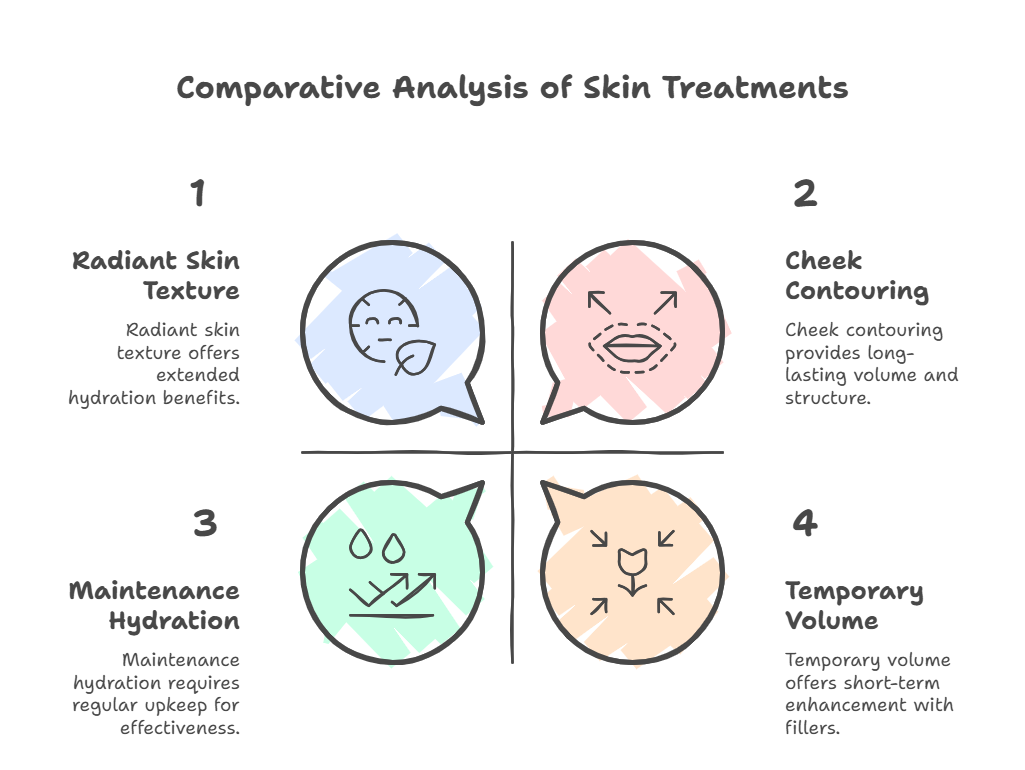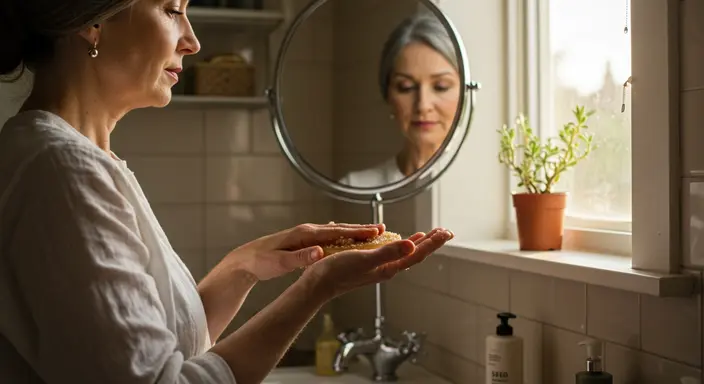We’ve all been there, scrolling through endless skincare routines and advertisements, feeling lost in a sea of promises. One term that’s been gaining a lot of attention is “skin booster”—but what is it, really?
“Boosters allow you to look like yourself, just more luminous.”
Dr. Amelia Hausauer
Skin boosters are no longer just about adding volume. They are changing as new techniques are tested, shared, and eventually adopted.
Understanding Boosters: Beyond the Surface
Traditional hyaluronic acid (HA) fillers used to be primarily for adding volume. They were like sculpting clay, used to shape areas like the cheeks or lips1. Now, things are a bit different.
Skin boosters are more like watercolors. They hydrate the skin from the inside out, improving its overall health and radiance. This addresses fine lines, dryness, and uneven skin tone subtly, without major changes to your face.
The Science of Skin Hydration
Hyaluronic acid, a key ingredient in skin boosters, is naturally found in our skin. This compound can hold up to 218 water molecules. It’s what keeps our skin naturally moist and plump.
Studies have shown HA’s role in keeping skin hydrated. Beyond immediate hydration, skin boosters can stimulate new collagen production. This makes the skin firmer and more elastic over time2.
It’s not as instant as regular fillers, so patience is needed.
Different Kinds of Skin Boosters
There are many formulas for boosters. This is good because they can offer different benefits and solve various problems.
Some use minimally cross-linked hyaluronic acid. Others might use non-cross-linked HA. Each type has its own advantages.
Here are some of the ingredients in boosters:
- Hyaluronic Acid (HA): Naturally found in our skin, known for keeping skin hydrated.
- Poly-L-lactic Acid (PLLA): Originally made for those with volume loss.
- Polynucleotides (PN): A natural biostimulator from salmon or trout.
- Platelet-Rich Plasma (PRP): Comes from your own blood, using concentrated platelets.
- Glycerol:: Acts as a humectant, increasing skin hydration.
Delivery of the Skin Booster
It all starts with a check-up. Make sure the person you see is experienced with facial and skin issues.
A key feature of skin boosters is how they’re applied. Microdroplet delivery is common, but sometimes the delivery isn’t precise.
Considering Skin Booster? What to Ask
If you’re thinking about a booster, it’s important to learn more. Start by talking to your dermatologist.
Choosing an injector who understands facial anatomy is very important. While side effects with hyaluronic acid are usually mild (redness, swelling, bruising), more serious problems can happen if a provider lacks experience.
Skin Booster Uses
Skin boosters are very effective. Let’s discuss the different types and how they’re used.
People choose skin boosters, and injectables in general, for many reasons. Skin boosters help with the effects of aging skin3.
Areas Where Skin Boosters Are Commonly Used
These treatments work well in certain areas. Common areas include the cheeks, lower face, and even lines around the upper lip.
The neck, chest, and backs of the hands are also popular. Boosters are great for acne scarring because they improve skin health and repair.
If you’ve had stubborn acne that left marks, these boosters deeply hydrate your skin. This leads to smoother skin.
Alternative Uses
There’s more to know beyond the usual uses. For example, skin boosters can add much-needed hydration to aging hands.
Dealing with dull, dry skin? A booster can provide the moisture you need. The great thing is, boosters can reduce those fine lines and wrinkles by plumping the skin4.
Even concerns like sagging skin and stretch marks can be improved with the right approach. If you want to enhance your skin’s firmness and resilience, check out our guide to boosting skin elasticity.
Realistic Expectations with Skin Booster Treatment
It’s important to be realistic about the results. Skin boosters offer a subtle improvement.
The immediate effect might be small. But over time, you may see improved firmness and fewer fine lines.
One 2019 study showed that a specific HA skin booster worked well when used early, before major problems developed. The research showed it was effective and safe5.
Skin Boosters vs. Traditional Fillers
Both boosters and traditional fillers often use hyaluronic acid, but they have different goals. It’s helpful to think about your personal skin goals first.
Traditional fillers add volume and focus on shaping, like lifting the cheeks or defining the jawline. Skin boosters are different, improving the texture, tone and offer hydration over added volume. Some may choose to look into lip fillers, specifically.
Beyond Injectables: Supporting Skin Health
While boosters work internally, external care matters too. Maintaining healthy skin involves habits you can control.
- Consistent, gentle skincare protects our skin’s natural barrier.
- Being sun-safe is important for our skin’s long-term health.
- Staying hydrated is important for overall health, including skin vibrancy.
Some in-office procedures are similar to boosters, but without injections. Microneedling is one method that boosts collagen. There are also laser treatments, which can make the skin brighter by increasing cell turnover and it may help with hyperpigmentation.

You may even choose to undergo laser hair removal to feel the most comfortable in your own skin. There are so many options.
Frequently Asked Questions
What does a skin booster do?
A booster hydrates your skin from within, improving its overall health and quality. Boosters add moisture for healthier skin.
The injections help with problems like fine lines and rough texture. It gives a boost to your skin’s appearance without adding fullness.
How long do booster results last?
How long results last depends on the booster. Some treatments need multiple sessions, spaced over four weeks.
Others need maintenance treatments about every five months. Sometimes, benefits can last for about a year, or even less.
What is the best skin booster product?
The best booster is a decision to make with a dermatologist. They will customize the choice to your skin’s needs.
Your goals are important for finding a treatment that’s personalized for you. Your dermatologist can review key ingredients in your consultation.
Is skin booster better than filler?
It’s hard to say which is “better,” because boosters and traditional fillers have different purposes. Skin boosters greatly increase hydration and improve overall skin quality.
Fillers, however, are great at adding volume and structure. Your choice depends on your goals, and your dermatologist can offer valuable advice.
Conclusion
Skin booster treatments represent a significant change. Skincare goals are moving from just fixing the outside to focusing on the skin’s natural health and ability to repair itself.
Skin boosters provide subtle changes with real benefits. Results and how long they last will vary.
Aging is less scary if we are proactive. Skin boosters could be what we need to keep a youthful and healthy look as we get older.
Small Step, Big Impact
Before considering skin booster treatments, consult with a qualified dermatologist to assess your skin’s needs, discuss potential benefits and risks, and develop a personalized skincare plan.
Listen to this article
This is an AI generated Podcast version of the article.
- https://www.mdpi.com/2073-4360/16/19/2739[↩]
- https://www.researchgate.net/publication/369941160_The_Effectiveness_of_Injectable_Hyaluronic_Acid_in_the_Improvement_of_the_Facial_Skin_Quality_A_Systematic_Review[↩]
- https://continentalhospitals.com/blog/the-benefits-of-skin-boosters-for-hydrated-and-glowing-skin[↩]
- https://www.sknplus.co.uk/blog/skin-boosters-guide[↩]
- https://pmc.ncbi.nlm.nih.gov/articles/PMC10082573/[↩]



